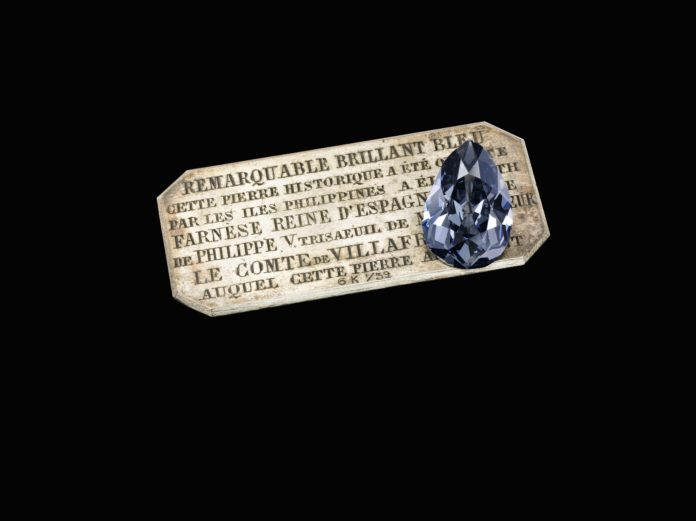The Elisabeth Farnese Blue Diamond, an exceptional historic diamond that has been kept in the same family for over three centuries, will go on sale for the first time in its history in May.
This 6.16-carat pear-cut blue diamond was presented to Elisabeth Farnese, Queen of Spain and descendant of Pope Paul III, on the occasion of her marriage in 1714 to Philip V, King of Spain and grandson of Louis XIV. Spain was recovering from a 13-year war of succession that had drained the country's coffers. To celebrate their new queen, the New World colonies were enjoined to send sumptuous gifts. It would take a year to collect these treasures.
In August 1715, the Golden Fleet left Cuba. Twelve vessels carried a fortune in gold ingots and a cassette containing enormous emeralds. A hurricane sinks eleven of them off Florida. The fleet from India was luckier, reaching Madrid. Elisabeth received a 6.16-carat blue diamond from the governor of the Philippines.
The color blue has often been associated with royalty, and blue diamonds were, in the 16th and 18th centuries, the royal gift par excellence. Like the mythical Hope (Le Bleu de France, which belonged to Louis XIV) and Wittelsbach diamonds, the Farnese Blue diamond certainly comes from the legendary Indian mines of Golconde, the only known source of diamonds until the discovery of mines in Brazil in the 1720s.
For three centuries, the diamond, worn by both the men and women of the family, traveled throughout Europe, following the unions of the descendants of Elisabeth and Philip of Spain with the continent's greatest dynasties.
Elisabeth Farnese passed the diamond on to her favorite son Philippe (1720-1765), Duke of Parma and founder of the House of Bourbon-Parme. On her death, her son, Ferdinand (1751-1802), inherited the stone who, at the same time as Napoleon invaded Italy, gave it in turn to his son Louis I (1773-1803), then to his grandson, Charles II (1799-1883), who became Duke of Lucca following the Congress of Vienna in 1815.
It was Charles II, known for his bohemian lifestyle and taste for travel, who had the diamond made into a tie-pin. Two years after regaining the throne of Parma in 1847, he abdicated in favor of his son, Charles III (1823-1854), assassinated in 1854. The diamond then fell to Robert I (1848-1907), Charles II's grandson and the last reigning Duke of Parma.
Following Italian unification, Robert I took refuge in Austria. During his exile, he had the diamond set on a diadem that had belonged to his mother, Louise Marie Thérèse d'Artois (1819-1864), who had inherited it from her aunt and adoptive mother, Marie-Thérèse de France (1778-1851) "Madame Royale", daughter of Louis XVI (1754-1793) and Marie-Antoinette (1755-1793). The diamonds adorning this jewel appear to have belonged to Queen Marie-Antoinette.
When Robert I died in 1907, his son Elias of Bourbon, Duke of Parma (1880-1959), inherited the diadem and the blue diamond. His wife, Marie Anne of Habsburg (1882-1940), Archduchess of Austria, drew up a detailed inventory describing the fascinating history of these two jewels.
The sale of the Farnese Blue diamond comes at a time when the appetite for jewels of royal and aristocratic provenance has never been stronger. In 2007, twenty years after the historic sale of the Duchess of Windsor's jewels, Sotheby's organized its first sale entirely dedicated to this type of jewelry. Since then, the market has gone from strength to strength. Over the past ten years, Sotheby's has sold more than 1,100 lots in this category
category for nearly $285 million. Top lots include the legendary Beau Sancy, a 34.98-carat diamond worn by Marie de Médicis at her coronation alongside Henri IV in 1610, sold for 9 million francs ($9.7 million) in 2012, and the Tiare de Donnersmarck, composed of 11 exceptional emeralds weighing over 500 carats, sold for 11.3 million francs ($12.7 million) in 2011.
According to David Bennett, Global President of the Haute Joaillerie Department and President of
Sotheby's Switzerland: "It is difficult to put into words the emotion felt when holding in one's hands such a treasure, discovered hundreds of years ago in the
Golconde mines in India. This stone bears witness to over 300 years of history, and its color is reminiscent of the finest Golconde blue diamonds, such as the famous Hope Diamond."


